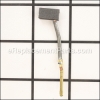Nibbler Replacement Parts
Search By Nibbler Model or Part Number
Most Popular Nibbler Replacement Parts
Genuine OEM replacement
This brush is sold individually, 2 are needed for this tool
It is always best to replace both brushes, even if only one is worn.
Worn brushes frequently are the cause behind a motor running poorly.
Replacing brushes can fix a motor that’s operating intermittently.
New brushes can restore a motor’s electric braking.
Carbon brushes are one of the most commonly replaced power tool parts. This is because carbon brushes are wear items, meaning that through friction and use they will gradually wear away until they need replacing. Worn brushes are a common causes of intermittent motor function, reduced electric braking and reduced motor power. A worn-out brush will often be worn down near to the wire lead and can be cracked, pitted, or burned. When replacing carbon brushes, be sure to inspect your armature for burns, cracks, or other damage which can indicate larger motor problems.
There are over 120 tool that use this brush.
This cord is made for double insulated tools
It is a two wire cord with two prongs and does not need a ground wire.
It is used on all of the Metabo tools shown below.
Replacing this power supply cord you will need a screwdriver.
• Remove the housing screws
• Remove the the housing
• Disconnect the old cord wires
• Remove the old power cord
• Secure the new cord in place
• Connect the wires
• Reassemble and test the new cord
This cord protector is a genuine DeWalt replacement part and is sold individually.
Cord Protectors are designed to slide onto your cord and fit securely at the end, where it’s firm rubber will protect the base of the cord from getting bent and pinched, which can expose the wires and become a safety hazard.
Popular Nibbler Models
Shop Nibbler Parts by Brand
Nibbler Help & Repair Articles
| How to Diagnose a Bad Power Cord or Switch | How to Remove an Armature Bearing with a Vise |
 |  |
| This article outlines the basics of power tool and appliance electrical diagnosis. You can use a multimeter to test... | This article explains one backup method for removing armature bearings when a bearing puller isn't... |


































































